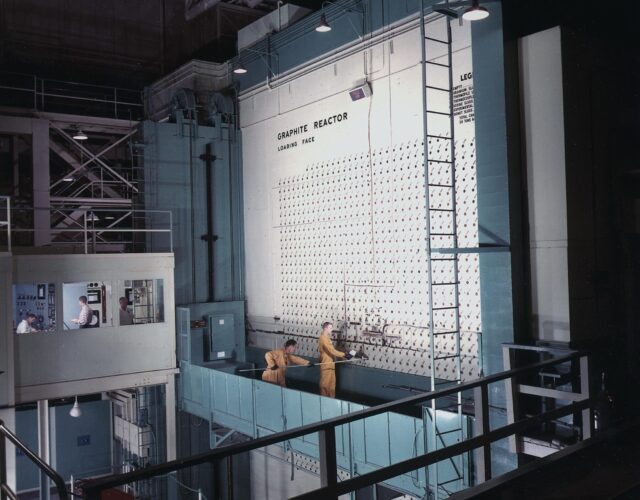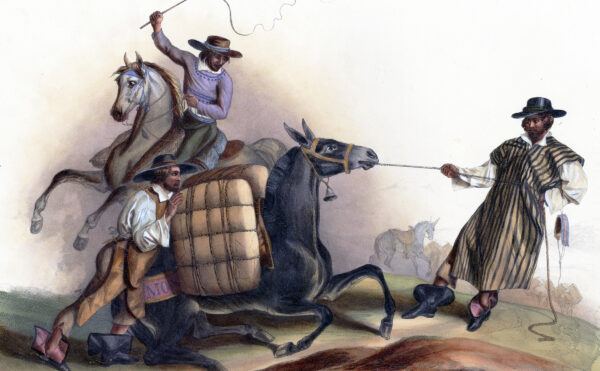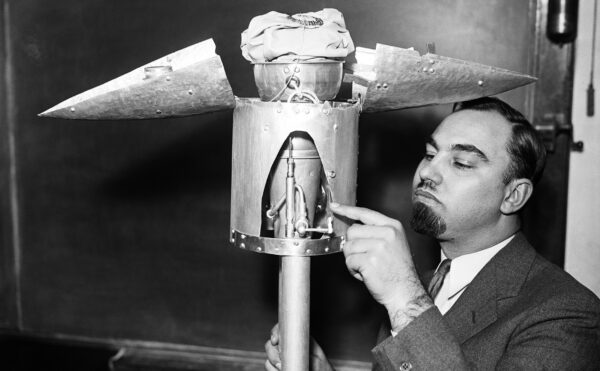Angela N. H. Creager. Life Atomic: A History of Radioisotopes in Science and Medicine. University of Chicago Press, 2013. 489 pp. $45.
A few years ago while traveling in East Tennessee I arranged to visit the Oak Ridge National Laboratory. For a long time I have taught a course on the history of the atomic bomb, and I wanted to see for myself the place where so much of the work was done. During World War II the United States pursued two very different paths to nuclear weapons, building enormous plants in Oak Ridge to separate out atoms of U-235, the fissile isotope of uranium, and giant reactors in Hanford, Washington, to produce a completely new element, plutonium. Both delivered their deadly products to J. Robert Oppenheimer’s secret lab in Los Alamos, New Mexico, to be fashioned into bombs, but otherwise the two branches of the project went along largely independently, even as they came to nearly simultaneous fruition in July and August 1945.
The most interesting sight at Oak Ridge today is one that, in light of the division of the project, doesn’t really belong there at all: the X-10 reactor. It appears on the cover of Angela Creager’s book Life Atomic and is in many ways the centerpiece of the fascinating story she tells. When General Leslie Groves took over the Manhattan Project in September 1942, he planned to produce all of the bomb material—both U-235 and plutonium—at Oak Ridge, and work proceeded apace there on the huge isotope separation plants needed to sift out enough U-235 to make a bomb. Early in 1943 construction began nearby on the graphite-moderated, air-cooled X-10, intended as a pilot plant for later plutonium production reactors. But even as work on the X-10 was starting up, scientists realized that air cooling wouldn’t suffice for full-scale production reactors. Moreover, Groves concluded that Oak Ridge, just 20 miles from Knoxville, was not isolated enough for the dangerous work of producing large amounts of plutonium. He settled instead on the sprawling site at Hanford, in the scrublands of central Washington State, where the production reactors could be cooled by water from the nearby Columbia River.
All of this left the X-10 something of an orphan: set amid the separation plants of Oak Ridge, it was far from the main centers of reactor work and no longer really a prototype for anything. Nonetheless, the little reactor proved invaluable. By the end of 1943 it had produced the first small amounts of reactor-bred plutonium, crucial for early experiments at Los Alamos. Project personnel also used it to work out chemical processes for extracting plutonium from the spent fuel—a tricky job and one that, given the intense radioactivity, had to be carried out by remote control. Most important for Creager’s story, the Oak Ridge reactor excelled at producing radioisotopes, both from the fragments of split uranium nuclei and from target materials exposed to the bath of neutrons in its core. The X-10 became the workhorse of American radioisotope production for the next two decades, and in the process it transformed scientific fields seemingly far removed from nuclear physics.
From the time when Marie and Pierre Curie first isolated radium in the late 1890s, radioactive substances had been seen as holding the secret of life and health. The successful use of radium to treat cancer reinforced this impression, though there were soon dark hints that radiation could cause cancer as well. By the 1920s scientists were also using natural radioisotopes as tracers, illuminating biological processes by following atoms through sequences of chemical reactions. Ernest Lawrence greatly advanced this work in the 1930s when he began using his new Berkeley cyclotron to produce sodium-24, iron-59, and other biologically useful radioisotopes virtually to order. Radioisotopes remained scarce, however, and as Creager shows, they soon became part of a global network of gift giving among the small circle of scientists working in the field.
The Manhattan Project and the X-10 changed all that, as the informal exchange of radioisotopes among scientists gave way to their mass production and distribution by government agencies—first the Manhattan Engineer District and then, from 1947, the Atomic Energy Commission (AEC). Eager to promote what came to be called Atoms for Peace, the AEC subsidized the production of these useful isotopes and encouraged their application in biomedical research and therapy. Much has been written about how the development of nuclear weapons affected postwar work in physics, as it stoked the growth of Big Science, entangled scientists with the military, and landed them in a series of troubling ethical dilemmas. Creager takes up the parallel developments in the life sciences, using the story of radioisotopes as a “historical tracer” to illuminate key trends in American biology and medicine. “Once you raise a historical Geiger counter and scan the last half of the twentieth century,” she writes, “you find the chatter of radioactivity everywhere, not only around atomic weapons facilities but also concentrated in places where life was studied and diseases were diagnosed” (p. 22).
Access to radioisotopes was a boon to many areas of research, but the new regime brought restrictions as well. In its early days the AEC took a hard line against sharing even innocuous nuclear materials with foreign researchers, thus fumbling what many scientists saw as a unique opportunity to use the new abundance of radioisotopes to foster international scientific cooperation. The AEC eased up on its embargo after 1950, but by then Britain, Canada, and other countries had built their own reactors and could supply radioisotopes themselves. In any case, as Creager notes, the AEC saw the public-relations value of its radioisotope program steadily decline through the 1950s. Hopes faded that such isotopes would provide a “magic bullet” to cure cancer, while fears of genetic damage from nuclear fallout undercut whatever positive aura radioactive substances once held with the public.
Scientists continued, however, to make good use of radioisotopes throughout the 1950s. At Cold Spring Harbor on Long Island, Alfred Hershey and Martha Chase famously used phosphorus-32 and sulfur-35 to show that genetic information is carried by DNA rather than protein; at the University of California, Berkeley, Melvin Calvin used carbon-14 to explicate the complex chain of reactions behind photosynthesis; and at the Veterans Administration hospital in the Bronx, Rosalyn Yalow and Solomon Berson built on their work with radioactively labeled insulin to develop exquisitely sensitive radioimmunoassay techniques now widely used for blood screening and cancer diagnosis, as well as for biomedical research. Scientists put radioisotopes to use outside the lab as well, notably in pioneering studies by ecologists at Hanford and Oak Ridge of how various substances moved through the environment. These investigations led to the important and troubling discovery that phosphorus-32, strontium-90, and other environmental contaminants could become enormously concentrated as they moved up the food chain from plants to fish and birds, and perhaps to humans.
The AEC sponsored many experiments on the health effects of radiation and provided radioisotopes for other “off-project” studies, often carried out for the military. Some of these involved injecting unsuspecting patients with substantial doses of plutonium and other deadly substances. Even Joseph Hamilton, the California researcher who had run the first plutonium experiments, had qualms about the morality of such work, or at least how it might look to others. In 1950 he remarked that a proposal to expose prison “volunteers” to high doses of radiation had “a little of the Buchenwald touch” (p. 328). That plan was dropped, but equally objectionable experiments went ahead at labs and hospitals around the country, kept secret not to protect national security but simply to avoid public scrutiny. When these experiments finally came to light in the 1990s, the Department of Energy (successor to the AEC) apologized and paid damages to the survivors.
By then, use of radioisotopes by researchers had passed its peak. Their medical use has continued to rise, with physicians now ordering tens of millions of radioisotope-based procedures every year, mainly diagnostic imaging with technetium-90m. But in recent years a combination of safety concerns, cumbersome regulations, and the availability of new techniques has led many scientists to turn from radioisotopes to such alternatives as tagging with fluorescent proteins.
Though other reactors continue to produce radioisotopes, the X-10 was shut down in 1963 and is now preserved as a historical site. On my visit it had a distinctly retro feel, as if it belonged on the set of an old science-fiction movie. It is perhaps a fitting monument to an era, chronicled by Creager and by no means altogether past, when reactor-produced radioisotopes played key roles both in advancing scientific knowledge and in reshaping the way work in the life sciences is done.




